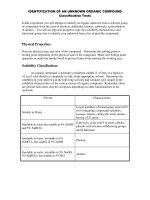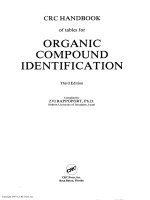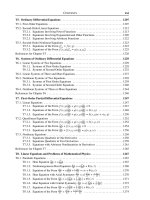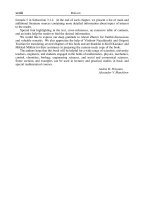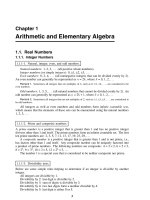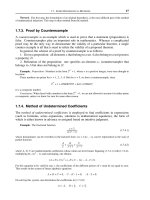rappoport - crc handbook of tables for organic compound identification 3e (crc, 1967)
Bạn đang xem bản rút gọn của tài liệu. Xem và tải ngay bản đầy đủ của tài liệu tại đây (14.15 MB, 502 trang )
CRC
HANDBOOK
of
tables
for
ORGANIC
COMPOUND
IDENTIFICATION
Third Edition
Compiled by
ZVI
RAPPOPORT, Ph.D.
Hebrew University
of
Jerusalem, Israel
CRC
Press,
Inc.
Boca Raton,
Florida
Copyright 1967 by CRC Press, Inc.
This book represents information obtained from authentic and highly regarded sources. Reprinted material is
quoted with permission, and sources are indicated.
A
wide variety of references are listed. Every reasonable effort
has been made to give reliable data and information, but the author and the publisher cannot assume responsibility
for the validity of all materials or for the consequences of their use.
Neither this book nor any
part
may be reproduced or transmitted in any form or by any means, electronic or
mechanical, including photocopying, microfilming, and recording, or by any information storage and retrieval
system, without permission in writing from the publisher.
Direct all inquiries to CRC Press, Inc.,
2000
Corporate Blvd., N.
W.,
Boca Raton, Florida,
33431
@
1967
by CRC Press, Inc.
Formerly The Chemical Rubber Company
International Standard Book Number (ISBN)
0-8493-0303-6
Former International Standard Book Number (ISBN)
0-87819-303-0
Library of Congress Card Number
63-19660
Printed in the United States
15 16 17
18
19 20
Printed on acid-free paper
Copyright 1967 by CRC Press, Inc.
First Edition
Tables for Identification of Organic Compounds
Compiled
by
Max
Frankel, Ph.D.
Saul Patai, Ph.D.
Assisted
by
Albert Zikha, Ph.D.
Robert Farkas-Kadmon
@
1960
by
SCIENCE PRESS,
LTD.,
JERUSALEM, ISRAEL
Second Edition
Tables for Identification of Organic Compounds
Compiled
by
Max
Frankel, Ph.D.
Saul Patai, Ph.D.
Assisted
by
Albert Zilkha, Ph.D.
Zvi Rappoport, Ph.D.
Robert Farkas-Kadmon
64
by
THE CHEMICAL RUBBER
CO.
Third Edition
Handbook of Tables
for
Organic Compound Identification
Compiled
by
Zvi Rappoport, Ph.D.
Copyright 1967 by CRC Press, Inc.
SELECTED
CRC
HANDBOOK
SERIES
CRC
HANDBOOK
OF
BIOCHEMISTRY
AND
MOLECULAR
BIOLOGY
Gerald
D.
F
asm
an
Brandeis
University
IN
CLINICAL
CRC
HANDBOOK SERIES
LABORA
TOR Y
SCIENCE
David
Seligson
Yale University
CRC
HANDBOOK
OF
ELECTROPHORESIS
Lena
A.
Lewis
Cleveland
Clinic
J.
J.
Opplt
Metropolitan
General Hospital
CRC
HANDBOOK SERIES
IN
ENGINEERING
IN
MEDICINE
AND
BIOLOGY
David
G.
Fleming
Case Western Reserve University
Barry
N.
Feinberg
Purdue University
CRC
HANDBOOK
OF
ENVIRONMENTAL
CONTROL
Richard
G.
Bond
Univeristy
of
Minnesota
Conrad
P.
Straub
University
of
Minnesota
CRC
FENAROLI'S HANDBOOK
OF FLA VOR
INGREDIENTS
Nicolo
Bellanca
CIBA-GEIGY
Corp.
Giovanni
Fenaroli
University
of
Milano, Italy
Thomas
E.
Furia
Dynapol
CRC
HANDBOOK
OF
MARINE SCIENCE
F.
G.
Walton
Smith
International Oceanographic Foundation
Frederick
A.
Kalber
Hydrobiological
Services
Joseph
T.
Baker
Vreni
Murphy
Roche Institute
of
Marine
Pharmacology,
Australia
CRC
HANDBOOK
OF
MATERIALS
SCIENCE
C.
T.
Lynch
Wright-Patterson
Air
Force Base
CRC
STANDARD
MA TH
TABLES
William
H.
Beyer
University
of
Akron
CRC
HANDBOOK
OF
MICROBIOLOGY
Allen
I.
Laskin
Esso Research
and
Engineering
Hubert
Lechevalier
Rutgers
University
Co.
CRC
HANDBOOK SERIES
IN
NUTRITION
AND
FOOD
Miloslav
Rechcigl,
Jr.
Agency
for
International Development
CRC
ATLAS
OF
SCINTIMAGING
FOR
CLINI-
CAL
NUCLEAR
MEDICINE
Henry
N.
Wellman
Indiana University
School
of
Medicine
CRC
ATLAS
OF
SPECTRAL
DATA
AND
PHYSICAL CONSTANTS
FOR
ORGANIC
COMPOUNDS
Jeanette
Grasselli
Standard
Oil
Company
(Ohio)
William
M.
Ritchey
Case
Western
Reserve University
CRC
HANDBOOK SERIES
James
H.
Steele
University
of
Texas
IN
ZOONOSES
Copyright 1967 by CRC Press, Inc.
CONTROLLED RELEASE PESTICIDES FORMULATIONS
By Nate
F.
Cardarelli, M.S., University of Akron.
DIFFUSE REFLECTANCE SPECTROSCOPY IN ENVIRONMENTAL PROBLEM-SOLVING
By R.
W.
Frei, Ph.D., Sandox, Ltd. (Switzerland), and J. D. MacNeil, M.Sc., Ph.D., Canada Department of Agri-
culture.
DRUGS AS TERATOGENS
By James L. Schardein, B.A., M.S., Parke, Davis and Company.
FUNDAMENTAL MEASURES AND CONSTANTS FOR SCIENCE AND TECHNOLOGY
By Frederick D. Rossini, Ph D., Rice University, Houston.
IMMUNOASSAYS FOR DRUGS SUBJECT TO ABUSE
Edited by S. J. Muld, Ph.D., New York State Narcotic Addiction Control Commission, et
al.
MASS SPECTROSCOPY OF PESTICIDES AND POLLUTANTS
By Stephen Safe, B.Sc., M.Sc., DJhfl., and Otto Hutzinger, Ing.Chem., M.Sc., Ph.D., National Research Council
of Canada.
MERCURY IN THE ENVIRONMENT
By
Lars
T.
Friberg, M.D., National Institute of Public Health (Stockholm), and Jaroslav
J.
Vostal, M.D., Ph.D.,
University of Rochester.
ORGANOPHOSPHORUS PESTICIDES: ORGANIC AND BIOLOGICAL CHEMISTRY
By Morifusa Eto, Ph.D., Kyushu University, Japan.
RECENT DEVELOPMENTS IN SEPARATION SCIENCE
Edited by Norman
N.
Li, Sc.D.,
Exxun
Research and Engineering Co.
TRACE ELEMENT MEASUREMENTS AT THE COAL-FIRED STEAM PLANT
By
W.
S. Lyon, Jr. B.S., M.S., Oak Ridge National Laboratory.
CRC
CRITICAL
REVIEWS~~
IN
ANALYTICAL
CHEMISTRY
Edited
by
Bruce H. Campbell, Ph.D.,
J.
T.
Baker Chemical Co.
CRC CRITICAL
REVIEWS~~
IN TOXICOLOGY
Edited by Leon Golberg, M.D., B.Chu., D.Sc., DiPhil., F.R.CiPath., Chemical Industry Institute of Toxicology
Direct inquiries to CRC Press, Inc.
Copyright 1967 by CRC Press, Inc.
PREFACE
The present volume is a revised and enlarged third edition of the book formerly
titled TABLES
FOR
IDENTIFICATION
OF
ORGANIC COMPOUNDS, Four new classes of com-
pounds, i.e., sulfonyl chlorides, sulfonamides, thiols and thioethers were added, bringing
the number of classes included in the book to twenty-six. The tables of alkanes,
alkenes, alkynes, aromatic hydrocarbons, phenols, nitriles and sulfonic acids were all
thoroughly revised and considerably enlarged. In all, the addition of 2400 compounds
to the third edition, raised the total number of parent compounds in the book to over
8150.
Three tables containing the dissociation constants of more than 1050 phenols, organic
acids and organic bases were added. Correlation charts for I.R., Far I.R. and N.M.R.
were also included.
Explanatory sections entitled "Explanations and References" precede the tables. In
these sections the formulas of the derivatives and the full reaction equations for their
preparation by the most important methods, together with some essential details and
references to their preparations, are given.
An index covering both the names and synonyms of the compounds was added at
the end of the book. An index listing the names of all tables and major subjects was also
added.
The main objective of this book is to assist chemists in the identification of organic
compounds. The organization of the compounds in classes according to increasing boiling
points should also assist in the search for standard vapor phase chromatography work.
For further information of techniques of organic analysis one or more of the following
books should be consulted:
N.
D.
Cheronis,
J.
B.
Entrikin and E. M. Hodnett,
Semimicro Qualitative Organic
Analysis,
3rd Ed., Interscience Publishers, New York, 1965.
L. Meites,
Handbook of Analytical Chemistry,
McGraw Hill Book Co., 1963.
F.
Feigl,
Spot Tests in Organic Analysis,
6th Ed., Elsevier Publishing Co., 1960.
A. I. Vogel,
A Textbook of Practical Organic Chemistry,
3rd Ed., Longmans Green and
Co., London, 1957.
R.
L.
Shriner, R.
C.
Fuson and
D.
Y. Curtin,
The Systematic Identification of Organic
Compounds,
4th Ed., John Wiley and Sons, New York, 1956.
F. Wild,
Characterization of Organic Compounds,
2nd Ed., Cambridge University Press,
1958.
The publication of the third edition would not have been possible without the work
of those involved in the preparation of the earlier editions. The editor is thankful for the
part in the earlier work contributed by Professors M. Frankel,
S.
Patai and
A.
Zilkha, and
the late Mr.
R.
Farkas-Kadmon. Thanks are due also to Mrs. E. Shohamy and Mr. A.
Glazer for assisting in collection of new data, to Mrs.
Y.
Elmaleh for typing the index,
and especially to Prof.
S.
Patai, who as consulting editor, read all the new material
and gave many helpful suggestions. The cooperation of Dr. Robert C. Weast and Mrs. F.
Thomas in the publication of the book is gratefully acknowledged.
z.
R.
Jerusalem
January
196
7
Copyright 1967 by CRC Press, Inc.
Contents
Abbreviations
Explanations and References to the Tables
Alkanes and Cycloalkanes
Gases, Liquids, Solids
Alkenes, Cycloalkenes, Dienes and Polyenes
Liquids, Solids
Alkynes (Acetylenes)
Liquids, Solids
Aromatic Hydrocarbons
Liquids, Solids
Halides
A)
Alkyl and cycloalkyl halides
1.
Chlorides, Liquids and Solids
2.
Bromides, Liquids and Solids
3
Iodides. Liquids and Solids
B) Dihalides and polyhdhdes (non-aromatic)
1
Fluondes
2
Chlorides, Liquids and Solids
3.
Bromides, Liquids and Solids
4.
Iodides, Liquids and Solids
C)
Aryl halides
1.
Fluorides, Liquids
2.
Chlorides, Liquids and Solids
3
Bromides, Liquids and Solids
4.
Iodides, Liquids and Solids
Aicohols
Liquids, Solids
Phenols
Liquids, Solids
Ethers
Liquids, Solids
Aldehydes
Liquids, Solids
Ketones
Quinones
Carboxylic Acids
Liquids, Solids
AcyI Halides
Acid Fluondes
AcyI Bromides, Liquids, Solids
AcyI Chlorides, Liquids. Solids
Acyl Iodides, Liquids, Solids
Acid Anhydrides
Liquids, Solids
Amides and Imides
Liquids, Solids
Esters
Liquids, Solids
Copyright 1967 by CRC Press, Inc.
Contents (Continued)
Ammo Acids
Amines
Primary and Secondary Amines
Tertiary Amines
Liquids, Solids
Carbohydrates
Liquids, Solids
Nitro Compounds
Liquids. Solids
Nitriles
Liquids, Solids
Sulfonic Acids
Sulfonyl Chlorides
Sulfonamides and Sulfonanilides
Thiols (Mercaptans)
Thioethers (Sulfides)
Acid Dissociation Constants of Organic Acids in Aqueous
Solution
Acid Dissociation Constants of Phenols in Aqueous
Solution
Dissociation Constants of Organic Bases in Aqueous
Solution
1.R Infra-red Correlations Charts
Far 1.R Far Infra-red Vibrational Frequency Correlation
Charts
NMR-Characteristic NMR Spectral Positions for
Hydrogen in Organic Structures
Miscibility of Organic Solvent Pairs
Emergent Stem Correction for Liquid-in-Glass
Thermometers
Correction of Boiling Points to Standard Pressure
Molecular Elevation of the Boiling Point
Molecular Depression of the Freezing Point
Carbohydrates
Fats and Oils
Waxes
Diamagnetic Susceptibilities of Organic Compounds
Four-Place Logarithms
Periodic Table of the Elements
Table of Atomic Weights
Index of Organic Compounds
Index listing names of tables and major subjects
Request for New Data
Copyright 1967 by CRC Press, Inc.
LIST
OF
ABBREVIATIONS
USED
MD
a
abs
abt
ac
a
ac anh
acet
add
al
alk
amor
anh
arom
aqu
asym
, as
blk
boil
bp.B
P
br
bz
brt
brnsh
Q
CQ
caust
chl
cl
-bz
col
comp
cone
cor
cr
,
cryst
d
d,D
dcnv
dehq
dil
dist
dk
dl
,
d,l,
D,
efflor
et
et
ac
eth
exp
f
i
fl
fluores
fp
frz
specific
rotation
acid
j
absolute
about
acetic
acid
acetic anhydride
acetone
addition
alcohol
alkali
amorphous
anhydrous
aromatic
aqueous
asymmetric
blue
black
boiling
boiling
point
brown
benzene
bright
brownish
cold
about
caustic
chloroform
chlorobenzene
colorless
compound
concentrated
corrected
crystals
decomposes
dextrorotatory
(or
D-configuration)
derivative
deliquescent
dilute
distillate
dark
L
racemic
efflorescent
ethyl
ethyl
acetate
ether
explodes
from
flakes
fluorescent
freezing
point
freezes
um
;Iac
'lit
?lyc
gran
grn
,
htng
hyd
hyg ,
hygr
;
i
ign
msol
1
,L
leaf.
If
lg
'gr
hq
Ing
It
Ivs
/Ti-
me
,
meth
micr
mixt
ml
mod
monohyd
monocl
m
p , M P
need
, nd
0-
ol
or
ord
org
orth
oxid
P-
pa
part
pet
pet
eth
ph
ph
hydraz
PhNO
2
pl
powd
fuming
glacial
glittering
glycerol
granular
green
hot
heating
hydrate
or
hydrolyses
hygroscopic
inactive
insoluble
ignites
insoluble
levorotatory
(or
L-configura-
tion)
leaflets
large
ligroin
liquid
long
light
leaves
mcts
methyl
microscopic
mixture
milliliter
modification
monohydrate
monochnic
melting
point
needles
ortho
olive
orange
ordinary
organic
orthorhombic
oxidation
para
pale
partly
petroleum
petroleum
ether
phenyl
phenyl
hydrazine
nitrobenzene
plates
powder
pr
purp
pyr
rac
reel
recr
redsh
rhomb
r
rh
s
sec
scar
s h
sh
si
sld
slend
sm
soft
sol
,
soln
solv
st
stab
subl
sym
tab
,
tabl
ten
tetr
tol
trans
thk
tncl
trim
uns
unst
vac
V
var
vic-
V1SC
volat
vlt
w
wh
yel
yelsh,
ylsh
>
<
oo
xyl
prisms
purple
pyndine
racemic
(or
racemate)
rectangular
recrystallization
reddish
rhombic
rapid
rapid
heating
soluble
secondary
scarcely
slow
heating
short
slightly
solid
slender
fm
oil
small
softens
solution(s)
solvent(s)
steel
stable
sublimes
symmetrical
tablet(s),
tables
tertiary
tetragonal
toluene
transparent
thick
tnchmc
tnmenc
unsymmetrical
unstable
vacuum,
in
vacuo
very
variable
vicinal
viscous
volatile
or
volatilizes
violet
water
white
yellow
yellowish
above,
greater than
below,
smaller
than
irascible
xylene
Copyright 1967 by CRC Press, Inc.
EXPLANATIONS
AND
REFERENCES
TO THE
TABLES
The
following
section gives explanations
and
references
for the
preparation
of the
derivatives appear-
ing
in
the
Tables
Formulas
of the
derivatives
as
well
as the mam
methods
for
their preparation
are
given
Usually, only
the
reagents
and the
solvents
required
for the
preparation
of a
derivative
are
mentioned
without
specific
details
for the
reaction conditions
and the
exact procedure
The
aim
of
these notes
is
mainly
to
enable
the
worker
to
choose
the
method preferable
in
the
conditions
and the
reagents available
to
him
in
his
labora-
tory
for the
denvatization
of
his
specific
compound
However,
THIS
IS
ONLY
A
REFERENCE
SECTION
AND NOT AN
INSTRUCTION MANUAL
AND THE
QUOTED
REFERENCES SHOULD
BE
CON-
SULTED
FOR THE
ACTUAL PREPARATION
OF
DERIVATIVES, ESPECIALLY REGARDING
SAFETY
HAZARDS INVOLVED
IN THE
WORK.
References
are
usually
given
for the
preparation
of all the
derivatives having
separate
columns
in
the
Tables,
as
well
as for
important ones listed
in
the
"miscellaneous"
section
of the
Tables References
to five
different
popular analytical textbooks
are
given, assuming that
at
least
one of
them,
or
another equivalent publication,
would
be
available
to the
worker
These
are
N
D
Cheroms,
J B
Entnkin
and E M
Hodnett,
Semimicro
Qualitative Organic Analysis,
3rd
edition,
Interscience,
New
York, 1965, quoted
in
the
text
as
"Cheroms
"
R
P
Linstead
and B C L
Weedon,
A
Guide
to
Qualitative Organic Chemical Analysis,
Butterworth
Scien-
tific
Publication,
London, 1956, quoted
in
the
text
as
"Linstead
"
R
L
Shnner,
R C
Fuson
and D Y
Curtin,
The
Systematic
Identification
of
Organic Compounds,
4th
edition, John Wiley
and
Sons,
New
York, 1956,
quoted
in
the
text
as
"Shnner
"
A
I
Vogel,
A
Textbook
of
Practical
Organic Chemistry,
3rd
edition, Longmans, Green
and Co ,
London,
1957,
quoted
in
the
text
as
"Vogel
"
F
Wild,
Characterization
of
Organic Compounds,
2nd
edition, Cambridge University
Press,
Cambridge,
1958,
quoted
in
the
text
as
"Wild
"
In
addition, leading references
from
the
original literature
are
also given Although
the
literature cover-
age
is
not
complete (especially
for the
common derivatives)
it
was
attempted
to
describe
different
methods,
and
to
give
as
many references
as
possible
to
less
common derivatives having limited
scope
More references
can
be
found
in
the
textbooks mentioned above
Derivatives
appear either
in
a
separate column
or
in
the
"miscellaneous"
section
in
the
Tables,
where
separate
columns
are
usually given
for
derivatives which
should
be
tried
first, and for
which enough
data
are
available
Derivatives which should
be
tried
as a
second choice,
or
preferred derivatives
for
which
not
enough
data
are
available appear
in
the
"miscellaneous" section
The
explanations
and the
references
for the
different
derivatives
are
arranged
usually
in
the
same
order
as
in
the
Tables
Occasionally,
this
order
is
changed
in
the
explanatory
notes
in
order
to
describe
the
derivatives
in
a
logical order
(eg,
in
Table
17
the
phenylurethane
appears
in
a
separate column, while
the
phenylhydantom
appears
in
the
"miscellaneous"
section
in
the
"ex-
planations
and
references" section
the
phenylhydantom
appears
directly after
the
phenylurethane)
Derivatives
which
are
followed
by an
asterisk
are
those recommended
for first
trial Other derivatives
should
be
tried
after
these
Although
"Ar"
usually
stands
for
monovalent
aromatic
group,
we
used
it
a few
times
in
the
following sec-
tions
as a
polyvalent aromatic residue
This
was
done only
for
demonstration purposes
Copyright 1967 by CRC Press, Inc.
EXPLANATIONS
AND
REFERENCES
TO
TABLE
I
As
a
result
of
their inertness
no
general suitable derivative exists
for
alkanes
and
cycloalkanes
Charac-
terization
is
based
only
on the
physical
constants
given
in
the
Table
melting
and
boiling
points,
index
of re-
fraction
and
density
Any
laboratory text-book
will
give
adequate
directions
for the
determination
of
these con-
stants
,,r*„
Copyright 1967 by CRC Press, Inc.
EXPLANATIONS
AND
REFERENCES
TO
TABLE
I
As
a
result
of
their inertness
no
general suitable derivative exists
for
alkanes
and
cycloalkanes
Charac-
terization
is
based
only
on the
physical
constants
given
in
the
Table
melting
and
boiling
points,
index
of re-
fraction
and
density
Any
laboratory text-book
will
give
adequate
directions
for the
determination
of
these con-
stants
,,r*„
Copyright 1967 by CRC Press, Inc.
TABLE
I.
ALKANES AND CYCLOALKANES
a)
Gases and Liquids (Listed in order of increasing
b.p.*)**
No
I
Name
Boiling
point, ¡
-
161 49
-
88 63
-42 07
-
32 86
-
11 73
-0 50
9
503
I3
I25
20 63
27 852
29
35 94
36 074
36 3
37
38 977
49 262
49 741
56 7"'
57 988
60
271
63 282
65 7755
68 74
70
64
71 812
79 197
80 5
80 738
80 882
86 064
87 846
89 784
90 052
90 773
91 725
91 850
91 869
93 475
98
I
2
3
4
5
6
7
8
9
10
11
12
13
14
15
16
17
18
19
20
21
22
23
24
25
26
27
28
29
30
3 1
32
33
34
35
36
37
38
39
40
41
42
43
44
45
46
47
48
49
50
5
1
52
53
54
55
56
57
58
Melting
point, 'C
Methane
Ethane
Propane
Cyclopropane
2-Methylpropane(1sobutane)
n-Butane
2,2-Dimethylpropane (Neopentane)
Cyclobutane
1,l-Dimethylcyclopropane
2-Methylbutane
trans-1.2-Dimethylcyclopropane
Ethylcyclopropane
n-Pentane
Methylcyclobutane
cis-1,2-Dimethylcyclopropane
Spiropentane
Cyclopentane
2,2-Dimethylbutane
1,1,2-Trimethylcyclopropane
23-Dimethylbutane
2-Methylpentane
3-Methylpentane
1.2.3-Trimethylcyclopropane
n-Hexane
Ethylcyclobutane
Methylcyclopentane
2,2-Dimethylpentane
2.4-Dimethylpentane
Cyclohexane
2.2.3-Trimethylbutane
33-Dimethylpentane
1,l-Dimethylcyclopentane
2.3-Dimethylpentane
2-Methylhexane
trans-1.3-Dimethylcyclopentane
cis-l,3-Dimethylcyclopentane
3-Methylhexane
trans-1,2-Dimethylcyclopentane
3-Ethylpentane
Quadricyclane (Quadricyclo [2,2,1 ,02 ',03 5]
heptane)
n-Heptane
2,2,4-Trimethylpentane
cis-1,2-Dimethylcyclopentane
Methylcyclohexane
Ethylcyclopentane
1,1,3-Trimethylcyclopentane
2,2-Dimethylhexane
2.5-Dimethylhexane
l,trans-2,cis-4-Trimethylcyclopentane
2,4-Dimethylhexane
2,2,3-Trimethylpentane
1,trans-2,cis-3-Trimethylcyclopentane
33-Dimethylhexane
2,3,4-Trimethy lpentane
1,1,2-Trimethylcyclopentane
2,3,3-Trimethylpentane
2,3-Dimethylhexane
3-Ethyl-2-methylpentane
'Derivative data given in order m p ,crystal color, solvent from which crystallized
**T
=
triple point,
S
=
at saturation pressure
Copyright 1967 by CRC Press, Inc.
TABLE
I.
ALKANES AND CYCLOALKANES
a) Gases and Liquids (Listed in order of increasing
b.p.* )
(Continued)
-
No
-
5s
64
6 1
62
63
64
65
66
67
68
69
70
71
72
7
3
74
75
76
7
7
78
79
80
8
I
82
83
84
85
86
87
88
89
90
9 1
92
93
94
95
96
97
98
99
100
101
102
103
104
105
106
107
108
109
110
Ill
112
113
114
115
1 I6
117
-
Name
1.~1s-2,trans4Trimethylcyclopentane
1,~~-2,trans-3-Trimethylcyclopentane
2-Methylheptane
4-Methylheptane
3.4-Dimethylhexane
l,~1~-2,c1~4TrimethylcycIopentane
3-Ethyl-3-methylpentane
3-Ethylhexane
3-Methylheptane
Cycloheptane (Suberane)
trans-1,4-Dimethylcyclohexane
1.1-Dimethylcyclohexane
cis-13-Dimethylcyclohexane
trans- l-Ethy l-3-methy lcyclopentane
trans-l-Ethyl-2-methylcyclopentane
CIS-l-Ethyl-3-methylcyclopentane
I-Ethyl-1-methylcyclopentane
2.2.4.4-Tetramethylpentane
l,c1~-2,~~-3-Trimethylcyclopentane
trans-1,2-Dimethylcyclohexane
2,2,5-Trimethylhexane
CIS-1.4-Dimertlylcyclohexane
trans-l,3-Dimethylcyclohexane
n-Octane
Isopropylcyclopentane
2,2,4-Trimethylhexane
CIS-l-Ethyl-2-methylcyclopentane
CIS-IJ-Dimethylcyclohexane
2,4,4-Trimethylhexane
n-Propylcyclopentane
23.5-Trimethylhexane
Ethylcyclohexane
2,2-Dimethylheptane
2,2,3,4-Tetramethylpentane
2,4-Dimertiylheptane
Methylcycloheptane
2.23-Trimethvlhexane
4-Ethyl-2-methylhexane
3-Ethyl-2,2dimethylpentane
4,4-Dimethylheptane
2,6-Dimethylheptane
2,5-Dimethylheptane
3.5-Dimethylheptane
Bicyclo[4.2.0)octane
cis-Bicydo[3.3.0]octane
2,4-Dimethyl-3-ethylpentane
1,1,3-Trimethylcyclohexane
3J-Dimethylheptane
2,2,5,5-Tetramethylhexane
23J-Trimethylhexane
3-Ethyl-2-methylhexane
trans-13.5-Trimethylcyclohexane
23.4-Trimethylhexane
CIS-1 AS-Trimethylcyclohexane
trans-1,2,4-Trimethylcyclohexane
2,233-Tetramethylpentane
4-Ethyl-3-methylhexane
3,3,4-Trimethylhexane
2.3-Dimethylheptane
'Derivative data given in order
m
p
,
Boiling
point,
'C
crystal color, solvent from which crystallized
4
Melting
point,
¡
Copyright 1967 by CRC Press, Inc.
TABLE
I.
ALKANES AND CYCLOALKANES
a) Gases and Liquids (Listed in order of increasing b.p.*)(Continued)
No
I
Name
Boiling
point,
T
140
141
142
143
144
145
146
147
148
149
150
151
152
153
154
155
156
157
158
159
160
161
162
163
164
165
166
167
168
169
170
17 1
172
173
174
175
176
Melting
point,
*C
Nopinane(7.7-Dimethylbicyclo[3
1 Ijheptane)
trans-1-Ethyl4methylcyclohexane
Cyclooctane
I-Ethyl-2-methylcyclohexane
n-Nonane
lJJ-TrimethyIbicycJo[2.2.1]heptane(Fenchane)
trans-I-Ethyl4methylcyclohexane
cis-1,1,3,5-Tetramethylc)clohexane
CIS-I-Ethyl-4methylcyclohexane
2.5.5-Trimethylheptane
2.4,4-Trimetbylheptane
2,3,3,5-Tetramethylhesene
2,2,4,4-Tetramethylhexane
Isopropy IcydOhexane
1.1J.3-Tetramethylcyclohexane
2,2,3,4-Tetramethylhexane
2,2-Dimethyloctane
3-Ethyl-2,2,4-trimethylpentane
3J.5-Trimethylheptane
2J.6-Trimethylkptane
2,4-Dimethyloctane
</,I-CIS-1-Ethyl-3-methylcyclohexane
d.1-2.5-Dimethyloctane
1,1,3,5-Tetramethylcyclohexane
n-Butylcyclopentane
n-Propylcyclohexane
2J.5-Trimethylheptane
2.5-Dimethyl-3-ethylhexane
2,4,5-Trimethylheptane
2.4-Dimethyl-3-isopropylpentane
2,2,3-Trimethylheptane
-
2,4-Dimethyl4ethylhexane
2.2-Dimethyl-34hylhexane
2.2J.4.4-Pentamethylpentane
1.1J.4-Tetramethylcyclohexane
5-Ethyl-2-methylheptane
2.7-Dimethyloctane
'Derivativedata given in order m p ,crystal color, solvent from which crystallized
5
Copyright 1967 by CRC Press, Inc.
TABLE
I.
ALKANES AND CYCLOALKANES
a) Gases and Liquids (Listed in order of increasing
b.p.*
)
(Continued)
-
Name
3,6-Dimethyloctane
3.5-Dimethyloctane
4-lsopropylheptane
2,3,3-Trimethylheptane
4-Ethyl-2-methylheptane
2,6-Dimethyloctane
2,2,3,3-Tetramethylhexane
Irons-1-Isopropyl4methylcyclohexane
(p-Menthane)
4.4-Dimethyloctane
2,3,4,STetramethylhexane
5-Ethyl-3-methylheptane
3.3-Dimethyloctane
4,S-Dimethyloctane
3,4-Diethylhexane
4-Propylheptane
l,l,4-Trimethylcycloheptane
(Eucarvane)
trans-l.2.3,S-Tetramethylcyclohexane
2.3,4,4-Tetramethylhexane
23.4-Trimethylheptane
3-lsopropyl-2-methylhexane
2,2,7-Trimethylbicyclo[2.2.1]heptane
(a-Fenchane)
3-Ethyl-3-methylheptane
2,4-Dimethyl-kthylhexane
3,4,4-Trimethylheptane
3,3,4TrimethyIheptane
3,4,5-Trirnethylheptane
2.3-Dimethyl-i-ethylhexane
1-Methyl-3-propylcyclohexane
2,3-Dimethyloctane
d,/-Pinane
2,394-Tetramethylhexane
33-Dimethyl4ethylhexane
5-Methylnonane
4-Methylnonane
3-Ethyl-2-methylheptane
3,4-Dimethyloctane
d-a-Pinane
d.1-l-lsopropyl-3-methylcyclohexane
(d.1-m-Menthane)
2.2.3.3.4-Pentamethylpentane
frans-l,2,4,S-Tetramethylcyclohexane
3.3-Diethylhexane
2-Methylnonane
/-l-Isopropyl-3-methylcyclohexane
(d-m-Menthane)
Boiling
point,
"C
Melting
point,
"C
'Derivative data given in order m p .crystal color solvent from which crystallized
Copyright 1967 by CRC Press, Inc.
TABLE
I.
ALKANES AND CYCLOALKANES
a) Gases and Liquids (Listed in order of increasing
b.p.*)
(Continued)
I
-
Name
I-Is0propyl4methylcyclohexane
(p-Menthane)
3.4-Dimethyl-3-ethylhexane
3A4.4-Tetramethylhexane
Cyclononane
1-lsopropyl-2-methylcyclohexane
(0-Menthdne)
CIS-l,2,4,5-Tetramethylcyclohexane
1-Methyl-1-propylcyclohexane
11-Decane
I-Methyl-4-propylcyclohexane
I-Methyl-2-propylcyclohexane
11-Pentylcyclopentane
n-Butylcyclohexane
trans-Decahydronaphthalene
(trans-Decdlin)
Isoamylcyclohexane
CIS-Decahydronaphthalene
(CIS-Decalin)
n-Undecane (n Hendecdne)
Cyclodecane
n-Pentylcyclohexane
n-Hexylcvclopentane
9-Methyl-tran~decahydronaphthalene
1.10-Dimethyl-tram-decahydronaphthalene
9-Methyl-CIS-decahydronaphthalene
n-Dodecane
1.10-Dimethyl-CIY-decahvdronaphthalene
n-Hexylcyclohexane
n-Heptvlcyclopentane
9-Ethyl-trans-decahydronaphthalene
9-Ethyl-cisdecahydronaphthalene
1-Methyl-/rmdecahydronaphthaJene
i-Tridecane
Bicyclohexyl
i-Octylcyclopentane
i-Heptvlcyclohexane
7-Tetradecane
7-Nonylcyclopentane
7-Octylcyclohexane
7-Pentadecane
i-Decylcyclopentane
i-Nonylcyclohexane
-Undecylcyclopentane
(n-Hendecylcyclopentane)
-Decylcyclohexane
LMethylheptadecane
7-Dodecylcyclopentane
I-Undecylcyclohexane (n-Hendecylcyclohexane)
I-Tridecylcyclopentane
I-Dodecylcyclohexane
I-Tetradecylcyclopentane
Boiling
point, OC
'Derivative data given in order m
p
,crystal color, solvent from which crystallized
Copyright 1967 by CRC Press, Inc.
TABLE
I
.
ALKANES AND CYCLOALKANES
b)
Solids (Listed in order of increasing
m.p.*)**
No
.
Name
I
2
Pentadecylcyclopentane
n-Hexadecane (Cetane)
3
4
5
Tridecylcydohexane
Hexadecylcyclopentane
n-Heptadecane
6
7
8
Tetradecylcyclohexane
Heptadecylcyclopentane
n-Octadecane
9
10
11
Pentadecylcydohexane
Octadecylcyclopenlane
n-Nonadecane
12
13
14
Hexadecylcyclohexane
Nonadecylcyclopentane
n-Eicosane
15
16
17
Heptadecylcyclohexane
Eicosylcyclopentane
n-Heneicosane
18
19
20
Ortadecylcyclohexaiw
Heneicosylcyclopentane
n-Docosane
2 1
22
23
27 Tetracosylcyclopentane
28 Heneicosylcyclohexane
29 n-Pentacosane
I
Docosylcydopentane
Nonadecylcydohexane
n.Tricosane
24
25
26
Eicosylcyclokxane
Tricosylcydopentane
n-Tetracosane
30
3 1
32
33
34
Pentacosylcydopentane
Docosylcyclohexane
Hexacosylcyclopentane
Nortricyclene (Tricyclo[2.2.1
.
Oa6]heptane)
n-Hexacosane
35
36
37
38
Melting
point.
¡
Cyclohexadecane
Tricosylcyclobexane
Heptacosylcydopentane
n-Heptacosane
39
40
41
42
Boiling
point. "C
Tetracosylcydohexane
Cyclopentadecane
Octacosylcyclopentane
n-octacosane
*Derivative data given in order: m.p., crystal color. solvent from which crystallized
.
**U
=
undercooled liquid
.
-
Copyright 1967 by CRC Press, Inc.
TABLE
I.
ALKANES AND CYCLOALKANES
b)
Solids (Listed in order of increasing
m.p.*)**
(Continued)
Name
Hexacosylcyclohexane
Triacontylcyclopentane
d.1-Isobornane
(2,2,3-Trimethylbicyclo[2
2
llheptane)
n-Triacontane
Heptacosylcyclohexane
Hentriacontylcyclopentane
n-Hentriacontane
Octacosylcyclohexane
Dotriacontylcyclopentane
n-Dotriacontane (Bicetyl)
Nonacosylcyclohexane
Tritriacontylcyclopentane
Tritriacontane
Triacontylcyclohexane
Tetratriacontylcyclopentane
Tetratriacontane
28-Methylnonacosane
Hentriacontylcyclohexane
Pentatriacontylcyclopentane
Pentatriacontane
Dotriacontylcyclohexane
Hexatriacontylcyclopentane
Hexatriacontane
Tritriacontylcyclohexane
Heptatriacontane
Tetratriacontylcyclohexane
Dctatriacontane
Pentatriacontylcyclohexane
Nonatriacontane
Hexatriacontylcyclohexane
retracontane
Morbornane (Bicyclo[2 2 llheptane)
!.2,3,3-Tetramethylbutane
Bornane (Camphane)
4damantane
Melting
point, 'C
Boiling
point, "C
*Derivative data given in order
m
p ,crystal color, solvent from which crystallized
**U
=
undercooled liquid
Copyright 1967 by CRC Press, Inc.
EXPLANATIONS
AND
REFERENCES
TO
TABLE
II
Bromine
addition
compound.
*
RCH=CHR'
+
Br
2
-»
RCHBr—
CHBrR'
Bromine
addition
compound
From
the
alkene
and
bromine
in
carbon
tetrachloride.
For
directions
and
examples
see: Cheronis,
p.
576;
Shriner,
p.
106.
From
the
alkene
and
bromine
in
water.
See:
Vogel,
p.
241.
From
the
alkene
and
bromine
in
chloroform.
See:
C. G.
Schmitt
and C. E.
Boord,
/
Amer. Chem. Soc.,
54, 751
(1932).
2,4-Dinitrobenzenesulfenyl
chloride
addition
compound.
*
NO
2
RCH=CHR'
+
0
2
N—
/
\—
SCI
—
RCHC1—
CHR'S—f
V-NO
2
2,4-Dinitrobenzenesulfenyl
chloride
adduct
From
the
alkene
and
2,4-dinitrobenzenesulfenyl
chloride
in
glacial
acetic
acid.
For
directions
and
examples see: Cheronis,
p.
577;
N.
Kharasch
and C. M.
Buess,
J.
Amer. Chem.
Soc.,
71,2724(1949);
D. J.
Cram,
J.
Amer.
Chem.
Soc.,
71,
3883
(1949);
N.
Kharasch,
C. M.
Buess
and
S.
I.
Stra-
shun,
J.
Amer. Chem.
Soc.,
74,
3422 (1952).
From
the
alkene
and
2,4-dinitrobenzenesulfenyl
chloride
in
benzene
or in
carbon
tetrachloride.
See:
N.
Kharasch
and C. M.
Buess,
/.
Amer.
Chem.
Soc.,
71,
2724
(1949).
S-Alkylmercaptosuccinic
acjd.
*
R
HSCHCOOH
RCH
2
CHSCHCOOH
RCH=CHR'
+|
-»
|
CH
2
COOH
CH
2
COOH
S-Alkylmercaptosuccinic
acid
From
the
alkene, mercaptosuccinic acid
and
benzoyl
peroxide
in
methanol.
For
directions
and
examples see:
J. G.
Hendrickson
and L. F.
Hatch,
/
Org.
Chem.,
25,
1747(1960).
Maleic
anhydride
adduct
(from
dienesj.
CHR
f
+
r~
co
>
-
I
CH
CH-CO^
CH
CH-CO
^
Maleic
anhydride
adduct
From
the
diene
and
maleic anhydride
in
benzene.
For
directions
and
examples
see: Linstead,
p.
5
1
;
Vogel,
p.
943.
From
the
diene
and
maleic
anhydride
in
xylene.
See: Linstead,
p. 51.
For
general
references
see:
M. C.
Kloetzel
in
Organic
Reactions, Vol.
4
(Ed.
R.
Adams), John Wiley
and
Sons,
New
York, 1948,
p.
1;
H. L.
Holmes
in
Organic
Reactions, Vol.
4,
(Ed.
R.
Adams), John
Wiley
and
Sons,
New
York,
1948,
p. 60; O.
Diels
and K.
Alder, Chem.
Ber.,
62,
2081
(1929).
Nitrosochloride
addition
compound.
RCH=CHR'
+
NOC1
—
•
RCH(NO)CHC1R'
Nitrosochloride
adduct
•Derivatives
recommended
for first
trial.
WARNING:
This
is
not an
instruction
manual.
References
should
be
consulted
for the
preparation
of
derivatives.
10
Handbook of tables for Organic Compound Identification, © 1967 CRC
Copyright 1967 by CRC Press, Inc.
EXPLANATIONS AND REFERENCES TO TABLE I1 (Continued)
From the alkene and nitrosyl chloride (prepared from sodium nitrite in concentrated hydrochloric acid)
in ether-acetic acid mixture.
For directions and examples see:
Linstead,
p.
52;
R.
Perrot,
Compt. Rend.,
203,329 (1936).
From the alkene and nitrosyl chloride (prepared from thionyl chloride and nitrogen trioxide) in ether.
See:
M.
Tuot,
Compt. Rend.,
204,697 (1937).
'Derivatives recommended
for
first trial.
WARNING:
This is not an instruction manual.
References should be consulted for the preparation of derivatives.
11
Copyright 1967 by CRC Press, Inc.
TABLE 11. ORGANIC DERIVATIVES OF ALKENES, CYCLOALKENES,
point
Ethene (Ethylene)
Propene (Propylene)
Cyclopropene
Allene
2-Methylpropene
'ram-2-Butene
Cyclobutene
-is 2-Butene
I
,2-Butadiene
(Methyldllene)
5-Methyl-1-butene
,4-Pentadiene
butadiene (Isoprene)
rant-2-Pentene
YY-2-Pentene
I-Methyl-l-ctclo-
butene
!-Methvl-2-butene
I-Methvl-1,2-buta- 40
diene (I
1
Dimethyl-
dllene)
Zyclopentadiene 40 83
'
.3-Pentadiene
(Piperylene)
DIENES AND POLYENES
a)
Liquids
1
)
(Listed in order of increasing
b.p.*)**
Melting
point
OC
-169 15~
-
185 25T
-
I36
-
140 35
-
185 35
-
108 92
-
105 55
-
138 91
-
136 19
-
168 49
-
148 28
-
165 22
-
137 56
-
145 95
-
140 24
-151 39
-
133 77
-85
-88 9
-1152
-87 47
-
140 82
dl-
dl-
tetra-
d/-
dl-
tetra-
di-
dt-
tetra-
di-
tetra
di-
dl-
dl-
tetra-
dl-
dl-
terra-
tetra-
A-
'efra-
leva-
Bromine addition product
>
83
-55 5
0 7
18 lgr
-
2
15 5 6
0.
eth
14 5. al
15, al
15,
dl
Miscellaneous
,4 Dinitrophenyl-
sulfenyl chloride,
86 7
.4-Dinitrophenyl-
sulfenyl chloride,
775 85
Aercdptosuccinic
acid adduct.
1073 6
4ercaptosuccinic
acid adduct,
122 3- 6
taleic anh adduct,
63-4, Igr
I
litrosochlor~de, 74.
Mercaptosuccinic
acid adduct,
153 7-4 0
limer 32, Maleic
anh adduct, 164
5 Benzoquinone
adduct, 75 6
laleic anh adduct,
61, pet eth
,
Oxid
by KMnO,
-
HCOOH
+
CH,COOH
*Derivative data given in order
m
p ,crystal color, solvent from which crystallized
**T
=
triple point,
S
=
at saturation pressure
Copyright 1967 by CRC Press, Inc.
TABLE 11. ORGANIC DERIVATIVES OF ALKENES, CYCLOALKENES.
Name
Cyclopentene
1,2-Pentadiene
(Ethylallene)
2.3-Pentadiene
(
I
3-
Dimethyldllene)
4-Methyl-I-pentene
3-Methyl-I-pentene
3-Methyl-1.4-penta-
diene
2.3-Dimethyl-I-butene
2-Methyl-1.4-penta-
diene
4-Methyl-crs-2-
pentene
4-Methyl-trans-2-
pentene
13-Hexadiene
(Biallyl)
2-Methyl-I-pentene
1-Hexene
2-Ethyl-I-butene
lrans-1.3-Hexadiene
3-Methylcyclopentene
CIS-3-Hexene
3-Hexene (CIS-lrans
mixture)
trans-3-Hexene
2-Methyl-2-pentene
3-Methyl-trans-2-
pentene
trans-2-Hexene
2-Hexene (CIS-trans
mixture)
2.3-Hexadiene
2.3-Dimethyl-l.3-
butadiene
:IS-2-Hexene
t-Methyl-1.2-penta-
diene (l-lsopropyl-
allene)
l-Methyl-cu-2-
pentene
Boiling
point
-c
14 24
14 86
18
27
3 88
i4 14
>5
i5 67
i6
16 3
18 55
9 46
10 7
13 49
14 6
145 55
15 0
16
44
16 6-67
17 08
17 29
7 63
17 87
179 8
1
8
8 78
8 84
0
0 45
-
DIENES AND POLYENES
a)
Liquids
I
)
(Listed in order
of
increasing
b.p.)*
(Continued)
Melting
point
OC
-
135 08
-
137 26
-
125 26
-
153 63
-1530
-
157 27
-
134 43
-
140 81
-
140 8
-135 72
-
139 82
-131 53
-
137 82
-11343
-135 7
-
134 84
-
132 97
-76 01
-141 14
-138 45
K
Bromc
-
dl-
tetra-
dl
dl
dl-
A
dl-
tetra-
A
A-
A-
'etra-
A
A-
h-
A-
il-
il-
il-
ll-
tetra-
/I-
/I-
-
Bromine addition product
Miscellaneous
Mercdptosuccinic
acid ddduct
142 8 3
1
Pseudo-
nitrosite 69 70
Perbenzoic acid
oxid -epoxy-
cyclopentane
bp 102
3
M~~c~~~osucc~~IIc
dcid ddduct
1026 9
311
HNO,
-
suc-
cinic ac 185
2,4-Dinitrophenyl-
sulfenyl chloride
61 2 Mercapto-
succinic acid ad-
duct. 94 5 5 7
i4ercaptosucciTiic
acid adduct,
152
1
6
i4aleic anh adduct,
78-9
*Derivative
data given in order m p
,
crystal color, solvent from which crystallized
Copyright 1967 by CRC Press, Inc.
TABLE 11. ORGANIC DERIVATIVES
OF
ALKENES, CYCLOALKENES,
Boiling
point,
2-Methyl-2,3-penta-
diene (Tr~methyl
allene)
1,4-Hexadiene
I-
723 25
4.4-Dimethyl-l-
pentene
1, (cis and/or trans)-!- 73
hexadiene
2.3-Dimethvl-2-butene 73 2
I
2-Ethyl-1.3-butadiene 75
4-Methylcyclopentene 75 2
I-Methylcyclopentene 75 8
2-Methyl-l,(cis and/or 76
trans)-3-pentadiene
1.2-Hexadiene 76
(H-Propylallene)
2-Methyl-l,(cis and/or 76
trans)-3-pentadiene
4-Methyl-13-penta- 76 3
diene
4.4-Dimethyl-trans-!- 76 75
pentene
3,3-Dimethyl-1- 77 54
pentene
1.33-Trimethyl-1- 77 87
butene
3-Methyl-1.3-penta- 78
0
3
dime
!raw-1.3.5-Hexatriene 78
5,
77 85
:is-1.3.5-Hexatriene 78 5
5-Methyl-l,2-penta- 79 70
diene
1,4-Hexadiene 79 4
81 6765
%-Methyl-1.5-hexa- 80-
1
diene
t.4-Dimethyl-l,2- 80-3
pentadiene (lert-
Butylallene)
pentene
I
DIENES AND POLYENES
a)
Liquids
1)
(Listed in order of increasing
b.p.)*
(Continued)
Melting
point,
-c
1366
74 28
127
115 24
134
3
109 85
79
104
8
135 46
r-Bromo
-
'etra-
2
form
il
it
'etra-
il-
i1-
i1-
kexa-
1.5-dl-
tetra-
il-
tetra-
2
forms
it-
Bromine addition product
MP.'C
I) 63 4
b
f p <-5
173 4 12
58-9
?8
182
18, iso-
merizes
-m
10
1,trans-
2.c~-3,
trans-4,
92,
1
,cis
2, trans-
3, trans-
4, 156
Miscellaneous
klercaptosuccinic
acid adduct, 119
0
5
ilaleic anh adduct,
95
6,
Igr
,SO2
adduct. 43-3
5
daleic anh adduct,
145-6, heptane,
Benzoquinone
adduct,
196
7, lgr
Copyright 1967 by CRC Press, Inc.
TABLE 11. ORGANIC DERIVATIVES
OF
ALKENES, CYCLOALKENES,
Boiling
2
3.4-Dimethyl-l-
pentene
Cyclohexene
2.4-Dimethyl-2-
pentene
3-Methyl-I-hexene
2,3-Dimethyl-I-
pentene
3-Ethyl-1-pentene
5-Methvl-irans-2-
hexene
2-Methyl-3-hexene
2.4-Dimethyl-2,3-
pentadiene (Tetra-
methylallene)
4-Methyl-I-hexene
3,4-Dimethyl-2-
pentene
4-Methyl-cis-2-
hexene
4-Methyl-lrans-2-
hexene
3,3-Dimethylcyclo-
pentene
2-Ethyl-3-methyl-l-
butene
1.3-Dimethylcyclo-
pentene
2-Methyl-1,s-hexa-
diene
2,4-Dimethyl-1.3-
pentadiene
1.4-Dimethylcyclo-
pentene
3-Methyl-irans-3-
hexene
I-Heptene
5-Methyl-CIS-2-hexene
5-Methyl-1.4-hexa-
diene
2-Methyl-I-hexene
DIENES AND POLYENES
a) Liquids
1)
(Listed in order of increasing
b.p.)*
(Continued)
9 1
91-2 5
92 0
Melting
point
*c
x-Bromi
-
di-
di-
di-
di-
d~-
di-
di
-
di-
dl
-
dl-
dl-
dl-
dl
-
di-
1.2-d~-
dl-
d1-
-
Bromine addition product
Miscellaneous
Mercaptosuccinic
acid adduct, 150 5
I
5, KMn0,
oxid
-
adipic ac
,
154,2,4-Dinitro-
phenylsulfenyl
chloride,
1
17
8
HBr
-
cyclo-
hexyl bromide,
b
p 165
klercaptosuccinic
acid adduct
103 4-
9
*Derivative
data given in order m p ,crystal color, solvent from which crystallized
Copyright 1967 by CRC Press, Inc.
